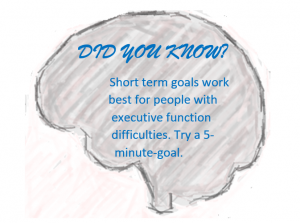Welcome to Module 4: Strategies to Help
In this module, we will explore how young people with Executive Function difficulties can be supported by those around them, to recognise where they might find things difficult, increase their skills over time, and manage in everyday life. Because Executive Function is such a vital part of our everyday lives, it is important to find survival strategies when problems arise.
When does Executive Function Matter?

Previous research has suggested that there are five types of situations that require high levels of Executive Function:
- Situations that involve planning or decision making
- Situations that involve error correction or problem solving
- Situations where responses are not well-practised or are new to the person
- Dangerous or technically difficult situations that might be overwhelming
- Situations that require you to change a previous response or resisting temptation
What can we do to help?
Consider the areas below, which suggest strategies that may help someone with difficulties in this area:
Putting it all together: Supporting Ben
Now let’s think about how these could be put into action with the children and young people you work with, by working through an example with Ben who we met in Module 1.
Case Details:
As a reminder Ben is 14-years-old, and has been in the care system since he was 8-years-old. His mother and father had a violent relationship, and both frequently misused drugs and alcohol. Ben maintains a positive relationship with his paternal grandmother and has intermittent contact with his mother, who is now separated from his father. Ben no longer has contact with his father, who was physically abusive to Ben before he was taken into care. He was fostered initially but the placement ended after 18-months when Ben became aggressive towards his foster siblings. He has been living in a multi-bed residential unit shared with two other children for the last 6 months.

Scenario:
During this time Ben has been quite settled but you have noticed that he has not been completing tasks as requested. When you have asked him to go upstairs, organise any washing up and bring it down, he has been appearing to go upstairs as requested, but some time later he is found lying on his bed. He states he forgot about your request, but it seems like he is doing this deliberately, as he does the same thing for other requests around the home.

Now let’s move on to our final summary to put together everything that we have learned during this course.
